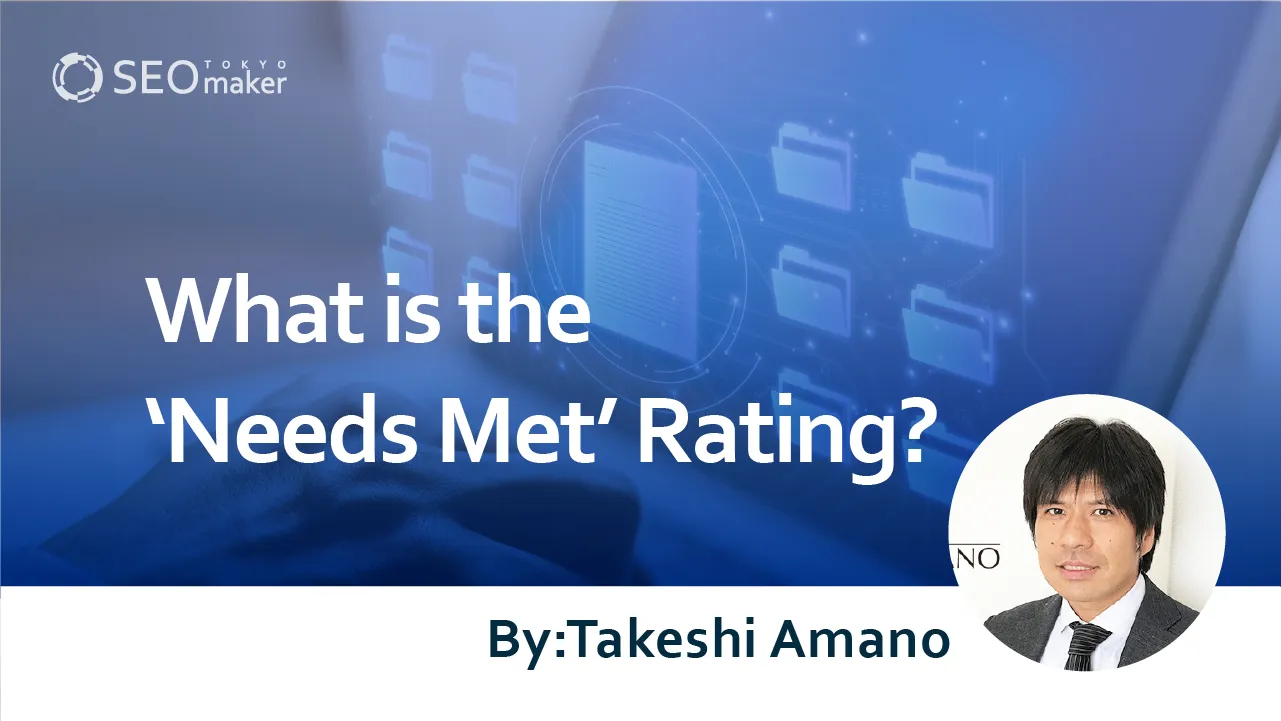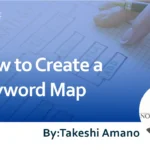What is the ‘Needs Met’ Rating? Explaining the Criteria and Its Relation to Page Quality
contents
- 1 What is ‘Needs Met’?
- 2 Criteria for ‘Needs Met’ Evaluation
- 3 Relationship Between Needs Met and Page Quality
- 4 Improving the Needs Met Rating
- 5 Frequently Asked Questions about Needs Met
- 6 Summary

When searching on a website or a page, there’s usually a specific purpose in mind.
For example, suppose you’re looking for a nearby restaurant to have lunch. You might use your smartphone to search for local dining options and then decide on a place based on the search results.
The ‘Needs Met’ rating is used to assess whether the search results fulfill the user’s search intent.
In this article, we will discuss the ‘Needs Met’ rating. Taking reference from the Search Quality Evaluator Guidelines, Tokyo SEO Maker, a specialist SEO media outlet, explains this concept in an easy-to-understand manner.
What is ‘Needs Met’?
‘Needs Met’ is a metric used to determine how well search results meet the needs of search users.
For website operators, it’s a metric used to assess how well a website satisfies the needs of search users. Essentially, ‘Needs Met’ is considered one of the evaluation criteria in SEO.
Related article: What is SEO?
In addressing ‘Needs Met’, it is important to consider what the search user wanted to know when they made their search. This is referred to as the user’s search intent. The keywords searched at this time are called queries.
Related article: What is Search Intent?
Related article: What are Search Queries?
‘Needs Met’ is introduced in the Search Quality Evaluator Guidelines
Google provides guidelines aimed at website operators on how to create high-quality content, known as the Search Quality Evaluator Guidelines.
‘Needs Met’ is featured within these guidelines, which outline items related to ‘Needs Met’ including
- Criteria for ‘Needs Met’ evaluation
- The relationship between ‘Needs Met’ and page quality
- Flagging inappropriate content that does not meet ‘Needs Met’
- Queries with multiple search intents
- Specific queries and web pages
- The relevance of ‘Needs Met’ to the freshness of information
- Spelling errors in queries and their impact on search results
- URL queries and search intent
Related article: What are the Search Quality Evaluator Guidelines?
Criteria for ‘Needs Met’ Evaluation
Quote: Search Quality Evaluator Guidelines
Based on the satisfaction of search users, the Needs Met rating is divided into five levels, ranging from the highest rating of ‘Fully Meets’ (FullyM) to the lowest rating of ‘Fails to Meet’ (FailsM).
|
Rating |
Explanation |
|
Fully Meets |
Almost all users are satisfied and do not require additional information. |
|
Highly Meets |
Very helpful for the majority of users, although some may still seek additional information. |
|
Moderately Meets |
Very helpful for the general user base, but there are instances where additional information is desired. |
|
Slightly Meets |
Helpful for some users, yet many others are seeking additional information. |
|
Fails to Meet |
Fails to be useful for almost all users, and nearly all are looking for more information. |
Understanding these five stages of Needs Met can guide you in setting the right keywords when building your website.
Definition and Specific Example of Fully Meets
Fully Meets (FullyM) is translated as “completely satisfied.” It is defined in the Search Quality Evaluator Guidelines as follows.
“A special rating category, which only applies to certain queries and results. All or almost all users would be immediately and fully satisfied by the result and would not need to view other results to satisfy their need.
Quote: Search Quality Evaluator Guidelines
Fully Meets refers to situations where almost all search users are satisfied, do not require additional information, and have no need to visit other web pages.
To qualify as Fully Meets, certain conditions must be met.
-The query and its intent must be clear.
-No further searches are necessary.
For example, the following types of sites meet these conditions.
-Sites that fulfill a specific intent to access a particular website or page.
-Sites that present accurate and reliable information from credible sources.
For the search query “amazon”
Quote: amazon
|
Query |
Amazon |
|
Search Intent |
To visit Amazon |
|
Relevant Site |
Amazon |
Users typing “amazon” or “アマゾン” almost always intend to visit the Amazon e-commerce site. While some might be interested in learning about the company or its services, Amazon’s site also provides corporate information. Thus, including exceptional cases, visiting Amazon can satisfy all search needs.
Definition and Specific Example of Highly Meets
Highly Meets (HM) is translated as “very satisfied.” It is defined as:
“Very helpful for many or most users. Some users may wish to see additional results.
Quote: Search Quality Evaluator Guidelines
Highly Meets refers to situations where the content is very useful for the majority of search users, though some may still seek additional information.
Results classified as Highly Meets typically deliver information that matches the search intent of the query, especially incorporating the following elements.
-Content quality
-Reliability
-Up-to-dateness
However, in areas like medical information that require high expertise, care must be taken. It may be necessary to have content supervised by experts to ensure accuracy.
For the search query “7 Eleven”
|
Query |
7-Eleven |
|
Search Intent |
To find a nearby 7-Eleven store, to visit the 7-Eleven corporate website |
|
Relevant Sites |
Google Maps / 7-Eleven corporate website |
People searching for “7-Eleven” typically have one of two main intents. The first is to use location information on their mobile device to find a nearby 7-Eleven store. Alternatively, some users want to visit 7-Eleven’s corporate website.
Suppose a user with the former intent ends up on the 7-Eleven corporate website. They won’t be able to achieve their goal of finding a nearby store through location data. As a result, they would need to search again and use Google Maps to locate the store.
Definition and Specific Example of Moderately Meets
Moderately Meets (MM) translates to “moderately satisfied.” It is defined as follows.
“Helpful for many users OR very helpful for some users. Some or many users may wish to see additional results.
Quote: Search Quality Evaluator Guidelines
Moderately Meets refers to a situation where the content is very helpful for many users or some users. However, many or some of these users may still want additional information.
Content that falls under Moderately Meets tends to have lower demand compared to Highly Meets.
Moderately Meets content matches the search intent of the query. However, it might face issues as follows.
- Information not being comprehensive
- Not updated with the latest information
- Lack of reliability in the sources
For the search query “Tokyo Shibuya”
|
Query |
Tokyo Shibuya |
|
Search Intent |
To find news, maps, and other information about Shibuya, Tokyo |
|
Relevant Sites |
Google Maps / News sites / Weather information sites / Transit information sites |
People searching for “Tokyo Shibuya” have various intents as follows.
- Wanting to view maps
- Reading related news articles
- Knowing the weather forecast
- Needing transit information
- Discovering tourist attractions
In this case, the query is ambiguous, making it hard to pinpoint the specific intent. Despite each site offering valuable information, these search results are classified as Moderately Meets.
Definition and Specific Examples of ‘Slightly Meets’
Slightly Meets” (SM) translates to “somewhat satisfying. Slightly Meets is defined as follows.
“Helpful for fewer users. There is a connection between the query and the result, but not a strong or satisfying connection. Many or most users would wish to see additional results.
Cited from: Search Quality Evaluation Guidelines
Slightly Meets refers to situations that are helpful to some search users. However, many search users desire additional information.
In this case, there is a relevance to the search query, and it can be helpful. However, the information provided does not fully align with the search intent. Reasons for this may include the following.
- Low quality of content
- Outdated information being provided
- Information being too niche for the search query
- Information spread being too broad for the search query
For the search query “Honda Odyssey”
Quote: Honda Auto News
|
Query |
Honda Odyssey |
|
Search Intent |
To know about the Honda Odyssey product |
|
Relevant Site |
Specs page for the 2010 model of the Honda Odyssey |
People searching for “Honda Odyssey” are generally looking for product information about the Honda Odyssey. Typically, they are interested in the specifications of the latest model. Therefore, users seeking information about the 2010 model are in the minority.
Definition and Specific Example of Fails to Meet
Fails to Meets (FailsM) is translated as “does not meet.” It is defined as follows.
“Completely fails to meet the needs of the users. All or almost all users would wish to see additional results.
Quote: Search Quality Evaluator Guidelines
Fails Meets refers to situations where the search does not meet the needs of users, prompting nearly all of them to desire additional information.
This evaluation applies when there are virtually no users or only a very few for whom the information might be useful. It’s possible that the information is completely irrelevant to the search query.
Moreover, content that is uncomfortable or contains violent depictions can negatively impact users, warranting a Fails Meets rating.
For the search query “Tanaka”
Quote : Google
Query: Tanaka Search Intent: To know about a person named Tanaka or information about companies and other entities named Tanaka Relevant Sites: All search results
|
Query |
Tanaka |
|
Search Intent |
To know about a person named Tanaka or information about companies and other entities named Tanaka |
|
Relevant Sites |
All search results |
People searching for “Tanaka” are looking for information about a person with that surname. However, Tanaka is a common surname in Japan, making it difficult to identify which specific individual is being searched for.
Additionally, there are several businesses in Japan such as “Tanaka Precious Metals” and “Kushikatsu Tanaka” that include ‘Tanaka.’ Due to the vast range of information available, it is unrealistic to expect the search results to satisfy all users.
Relationship Between Needs Met and Page Quality
The Search Quality Evaluator Guidelines outline the following rules regarding the relationship between Needs Met and Page Quality.
-Even if a page is of high quality, it will receive a low Needs Met rating if it doesn’t serve a useful purpose in the search results.
-Even if the information matches the query and is useful, the Needs Met rating can be lower if the page quality is poor.
Needs Met is an indicator that evaluates how helpful the search results are to the user from both the query and result perspectives. Therefore, Needs Met demands high page quality in the web pages displayed in search results.
On the other hand, Page Quality solely assesses how well a page achieves its goals. However, having high page quality does not necessarily translate to a high Needs Met rating.
Related Articles : What is Page Quality?
Improving the Needs Met Rating
To enhance the Needs Met rating, consider the following two points.
-Understand the search intent of the query.
-Improve page quality.
Understanding the Search Intent
Considering the search intent of a query is fundamental to improving the Needs Met rating. Search intents can be classified into four types.
-Know queries: Wanting to know.
-Do queries: Wanting to do.
-Buy queries: Wanting to buy.
-Go queries: Wanting to go.
For instance, if someone searches for “fan,” a primary intent might be “wanting to know which fan to buy” (Know query). To address this, you would cover the following aspects.
-Recommended fans
-Compact fans
-Stylish fans
-Fans with low electricity usage
-Price of fans
Meanwhile, there might also be a demand for “wanting to buy a fan” (Buy query), covering elements as follows.
-Fans on Amazon
-Fans on Rakuten
-Fans at Yodobashi Camera
-Fans at Yamada Denki
-Fans at home improvement stores
When creating content, it’s essential to write from the user’s perspective.
Related articles: What is search intent?
Related articles: What is search query?
Improving Page Quality
Page Quality refers to how well a page meets its objectives. A page is considered of high quality when it meets the following conditions.
-Understanding the purpose of the web page.
-Ensuring the safety of the web page.
-Considering E-E-A-T (Expertise, Authoritativeness, Trustworthiness, Experience).
-Considering YMYL (Your Money Your Life).
-Vetting the information provided.
-Using appropriate page titles.
-Including information about the content creators and enhancing their reputation.
-Enhancing the quality of the main content.
-Optimizing the placement of ads and side content.
The Search Quality Evaluator Guidelines clearly indicate that page quality impacts the Needs Met rating, making it essential to enhance page quality.
For detailed information on high-quality pages, please refer to the related articles on Page Quality.
Related articles: What is page quality?
Frequently Asked Questions about Needs Met
We present some common questions about Needs Met in an FAQ format.
Q: What does Needs Met mean?
A) It refers to how satisfied users are with the Google search results.
Needs Met is a concept defined by Google and detailed in the Search Quality Evaluator Guidelines.
Related Article: What are the Search Quality Evaluator Guidelines?
Q: Does Needs Met affect rankings?
A) Google does not explicitly state that it impacts rankings.
However, the evaluation of Needs Met is closely related to the search intent of users, which is a critical element in SEO. Reflecting the concept of Needs Met on a web page can ultimately affect the ranking of Google search results.
Summary
Needs Met is an indicator of the impact that search results have on users. Therefore, it is considered one of the metrics during SEO efforts for web operators. There are five evaluation criteria under Needs Met, but first, it is necessary to understand the definition of each criterion. Then, create web pages considering the user’s search intent. To enhance the rating of Needs Met, it is essential not only to understand the search intent of the query but also to improve page quality.










![What is a Description? Explaining the Meaning, Writing Style, and Changing Word Count – [2023 Edition]](https://www.switchitmaker2.com/en/wp-content/uploads/2024/09/what-is-description.webp)










